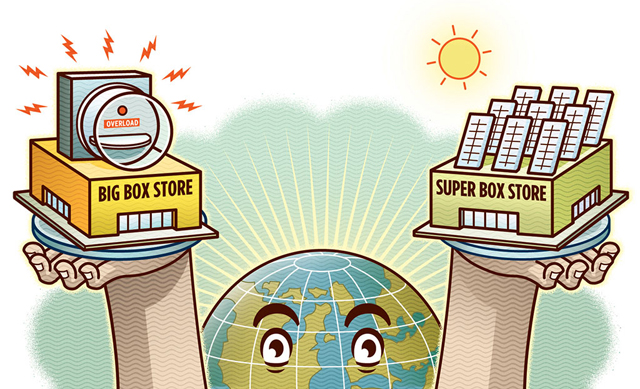sierraclub.org - sierra magazine - march/april 2013 - grapple: big box stores
Wingers Gang Up on Clean Energy | Critter: LOLsquid | Next Big Thing: Invasive Weeds? | The Wind Is Red |
On the One Hand . . . | Woe Is Us | Up to Speed

Peter and Maria Hoey
ON THE ONE HAND . . .
The physical footprint of big box stores ranges from huge to enormous-the largest ones can reach 200,000 square feet. Their carbon footprint is equally humungo: It can take up to 28,274 kilowatt-hours to power a single Walmart Supercenter for a day-as much power as 1,095 American homes use in the same time period. That's in addition to the 10,000 car trips each store generates every weekday (and more on Saturdays), according to the Institute for Local Self-Reliance. Plus there's the loss of the carbon-absorbing fields or forests the giant stores supplant. "Land-use change is one of the biggest contributors to global warming," says the institute's Stacy Mitchell.
ON THE OTHER . . .
Big box stores' massive size has one upside: lots of room for rooftop solar. The Solar Energy Industries Association reports that large chain stores use more self-generated solar energy than any other type of business. Some Walmarts, for example, get 30 percent of their power from rooftop solar. The four companies with the most on-site solar are Walmart (65,000 kilowatts), Costco (38,900 kW), Kohl's (36,474 kW), and Ikea (21,495 kW)-which has solar at 79 percent of its stores. What's driving these companies into the sunlight is pure pragmatism: Their big boxes are expensive to power, and solar gets cheaper by the day.
—Dashka Slater
Woe Is Us